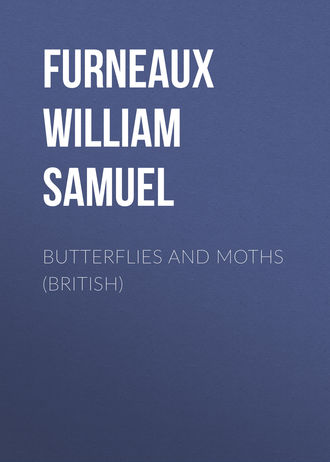 полная версия
полная версияButterflies and Moths (British)
The caterpillar is pale greenish, with a dark line along the back and on each side. It feeds on the cabbage and other cruciferous plants.
The moth flies from May to the end of the summer, and the caterpillar may be found about midsummer, and again in the autumn.
The Beautiful China Mark (Hydrocampa stagnata)
Fig. 214. – The Beautiful China Mark.
Our last example of the Pyralides– the Beautiful China Mark – belongs to the family Hydrocampidæ. This small family is remarkable for the fact that its four species spend their larval state in the water, feeding on the under surfaces of the leaves of water lilies and other aquatic plants. These curious larvæ live either in cases which they construct for their protection, something after the fashion of the larvæ of caddis flies, or quite free in the water, and then they are supplied with special breathing organs that enable them to absorb the oxygen held in solution in the water.
The moth we have selected for illustration is a very common species, and may be seen flying in great numbers in the neighbourhood of ponds during June and July.
The PterophoriThe members of this remarkable group are easily distinguishable from all other moths by the feathery appearance of their wings, a feature that has gained for them the popular name of Plume Moths. Their fore wings are more or less divided or cleft, and their hind wings are generally divided into three distinct feathery plumes.
The larvæ are hairy, and when full fed they suspend themselves by their anal claspers, and change to the chrysalis state without any kind of covering. They are generally to be found in spring and early summer, but some of them feed in the autumn.
The chrysalides are often hairy, though some of them are perfectly smooth.
Plume moths are to be met with more or less throughout the year. Many of the earlier species appear on the wing in spring and early summer; but the late feeders emerge in the autumn, and hybernate through the winter, often taking to the wing on the mild days of our coldest months.
The Pterophori include only about forty British species, all of which, with two exceptions, belong to the family Pterophoridæ. The two exceptions represent as many families – one the Chrysocorididæ, and the other the Alucitidæ.
Platyptilia gonodactylaThis is one of the commonest of the Pterophoridæ, generally appearing in our gardens and in waste places towards the end of May, and continuing with us for some time. It starts from its retreat at or before sunset, and remains on the wing after dark.

Fig. 215. – Gonodactyla.
Its fore wings are ochreous grey, with a narrow brown costal margin, and a triangular brown patch on the costa. Beyond this patch the wing is cleft. The hind wings consist of three distinct brownish plumes, the third of which has a small tuft of black scales projecting from the middle of the inner margin.
The caterpillar feeds on the flower stalks of the coltsfoot during March and April.
Leioptilus osteodactylusThis is another species of the same family. It is not uncommon, but is more local than the last.

Fig. 216. – Osteodactylus.
Its fore wings are pale yellow, with a small brown dot at the commencement of the dividing fissure, and a brown blotch on the costal margin nearer the tip. The hind wings are divided into three distinct plumes like those of Gonodactyla.
This is a later species, appearing on the wing in July.
Aciptilia pentadactyla
Fig. 217. – Pentadactyla.
The fore wings of this species are white, frequently with a few greyish scales, and are deeply divided into two feathery plumes. The hind wings are pure white, and consist of three plumes.
This pretty insect is common and widely distributed, and flies during June and July.
The caterpillar feeds on the convolvulus in May.
Alucita hexadactylaOur last example of the Pterophori is the Twelve-plume Moth, the only British representative of the family Alucitidæ.

Fig. 218. – Hexadactyla – Enlarged.
This little insect is of a yellowish colour, with two dark bands across the fore wings; and both fore and hind wings are divided into six distinct feathers. It is a common moth, and frequents sheltered spots, flying at dusk. It appears in August, remains on the wing till October, and then hybernates till the following April. During the winter it is commonly met with in outhouses and even in dwelling houses.
The caterpillar feeds during June and July on the flower buds of the honeysuckle (Lonicera Periclymenum). It is not hairy, like most of the larvæ of the last family; and, unlike these, it changes to a chrysalis in a silken cocoon.
CrambiThe third group of the 'Micros' is the Crambi, and contains about eighty species, arranged in four families.
Some of them are common moths with which all must be more or less familiar, as they are roused from the grasses on which they repose at almost every footstep as we walk through meadows in the summer. When at rest, they present a very peculiar appearance. Their wings are wrapped closely round their bodies in such a manner that they are hardly distinguishable from the stems on which they repose.
The larvæ have sixteen limbs, and are very variable in their habits. Some feed among moss or dry stems in silken tubes, some on the stems of reeds, and others inhabit the hives of bees and feed on the wax of the honeycomb.
The four families are:
1. Chilidæ– five species.
2. Crambidæ– about thirty species.
3. Phycidæ– over forty species.
4. Galleridæ– five species.
Chilo PhragmitellusThis species is one of those moths known as the 'Veneers,' and is popularly termed the Wainscot Veneer. It is one of the largest of the family Chilidæ.

Fig. 219. – Phragmitellus – Enlarged one-half.
Its fore wings are long, narrow, and pointed at the tip. They are of a pale ochreous brown colour, with a row of small black dots along the hind margin.
The caterpillar is pale grey, with brown stripes; and the head and second segment are yellowish brown. It feeds on the common reed (Phragmites) in the autumn, and hybernates till the following spring, when it resumes its feeding.
This insect is rather local, but may be searched for in all marshy places where reeds abound.
Crambus hamellus
Fig. 220. – Hamellus – Slightly enlarged.
The family Crambidæ is represented by the above-named species, which has the popular title of Pearl-streak Veneer. It is not a common moth, but is to be obtained in some localities by beating low herbage.
Its fore wings are ochreous and glossy, with a silvery streak from the base, running almost parallel with the costal margin. The hind margin is yellow, bordered inside by a wavy brown line. The hind wings are pale greyish brown with a yellowish margin.
Crambus tristellusThe same family contains the species Tristellus, which, unlike the preceding insect, is abundant everywhere.

Fig. 221. – Tristellus.
Its fore wings are generally yellowish brown, but exceedingly variable. A pale streak runs from the base to just beyond the middle of the wing, and is then forked. Near the hind margin is a very indistinct brown wavy line. The hind wings are dull smoke colour with a light fringe. As with the other moths of the family, its labial palpi are very long.
The moth flies from July to September.
Crambus hortuellusThis is also an abundant species, to be met with everywhere during June and July.

Fig. 222. – Hortuellus.
Its fore wings are dull ochreous brown. The wing rays are whitish near the inner margin, and a brown line with a silvery edging crosses near the hind margin. The hind wings are dull smoky brown, with a shining surface, and the fringe is light.
The larva is pale grey with dark grey spots, and may be found among moss in April and May.
Galleria mellonellaOur last example of the Crambi is a moth that the young entomologist is not likely to meet with unless he happens to be in the neighbourhood of one of its haunts, but its habits are so peculiar that we are tempted to introduce it on that account.

Fig. 223. – Mellonella.
It belongs to the family Galleridæ, the larvæ of which feed on the wax combs in the hives of bees and in the nests of wild bees. They are protected from the stings of the inmates by silken tubes which they construct, and by the hardened covering of their heads and front segments – the only parts that remain exposed while they are feeding.
The fore wings of the moth are reddish-grey or brownish, sometimes with a greenish tinge, and yellowish along the inner margin. The hind wings are greyish brown.
It flies in July and August, and the caterpillar feeds in May and June.
The TortricesThis is a large group of moths, deriving their name from the peculiar habit of a number of the larvæ of twisting or rolling up leaves for their protection. This habit, however, is not common to all, for some feed on stems and flowers, and others devour seeds and fruits.
The perfect insects may easily be known by the shape of the wings. The fore pair are gracefully curved on the costal margin in such a way that, when the insect is at rest with its wings closed, its outline is much the shape of a bell.
The identification of the various species of this extensive group is no easy task, for many of them are so variable in their colouring that insects of the same species are often very different from each other. So puzzling indeed is this tendency to run into varieties that many insects, once considered to belong to separate species, have been reduced to one; and this has been the case in a number of instances.
There are so many of these little moths that we cannot even give a representative of each family, but the following outline will serve to show the extensiveness of the group.
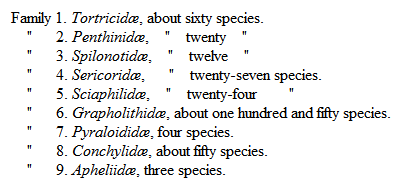
We shall now briefly examine a few of the commonest insects of the group.
Tortrix xylosteanaThis pretty moth is common in most parts, and may often be met with in abundance in wooded localities during July. It belongs to the family Tortricidæ.

Fig. 224. – Xylosteana with wings closed.
Its fore wings are ochreous brown. A very dark oblique streak, edged with yellow, runs from the inner margin of the base. A reddish patch in the centre of the wing, also edged with yellow, is narrow on the costa, and expands as it approaches the inner margin. Beyond this are another dark patch on the costa and two reddish-brown blotches on the hind margin.
The larva is greenish brown, marked with white spots which have black centres; and it feeds on oak (Quercus Robur), honeysuckle (Lonicera Periclymenum), and other plants, in the month of May.
Tortrix viridana
Fig. 225. – Viridana.
In June and July this pretty but destructive little insect may be seen flying in abundance in almost every oak wood. Its fore wings are one uniform pale green with the exception of a streak of yellow along the costal margin; and, when at rest, scores may exist on a single twig without being seen unless closely examined. The hind wings are of a pale smoky tint, and rather glossy.
The larva is green, with black spots, and feeds in May and June on the oak and other trees, often almost completely devouring the foliage.
Peronea cristana
Fig. 226. – Cristana – Enlarged.
This moth is not so generally abundant, but is very common in many of the woods of the south. It is remarkable for the large number of varieties that have been observed, many of which have been regarded as distinct species.
Its fore wings are of some shade of brown or grey, with a light streak of variable colour along the inner margin, and a tuft of raised white scales in the middle of the wing.
It flies during August and September.
Ptycholoma lecheanaOur last example of the family Tortricidæ is Lecheana, a moth that is common in most parts in June and July.

Fig. 227. – Lecheana.
Its fore wings are brown, lighter towards the base. There are no very distinct markings, but there is generally a darker patch in the middle of the wing, edged with a silvery streak on each side.
The larva feeds on several trees, including oaks and elms, in the month of May.
Penthina pruniana
Fig. 228. – Pruniana.
The next family —Penthinidæ– contains the common species Pruniana, which may be readily known by its boldly marked wings. The basal portion of the fore wings, to the extent of nearly two-thirds of the whole, is very dark brown. The remaining third is almost white, and clouded with grey. The hind wings are smoky brown with a paler fringe.
The caterpillar of this species feeds on the blackthorn (Prunus spinosa) in May, and the moth flies in June and July.
Antithesia salicellaThis moth is not nearly so common as the last species, but is fairly plentiful in some localities in the south of England. It belongs to the same family as Pruniana.

Fig. 229. – Salicella.
The fore wings are whitish at the base and along the inner margin, but the light tint is dotted and clouded with shades of brown. The remainder of the wings is marbled with dark brown of different depths, relieved near the hind margin with a little blue. The hind wings, as is usual with the Tortrices, are dull smoky brown.
The caterpillar is reddish brown with black spots, and feeds during May in rolled leaves of willows.
The moth flies in August and September.
Sciaphila octomaculanaOur single example of the family Sciaphilidæ is the species Octomaculana, which, though not very abundant, is widely distributed, and moderately common in parts.

Fig. 230. – Octomaculana – Enlarged.
Its fore wings are white, dusted with grey, and each is marked with four dark grey patches which have given rise to its specific name – a word which signifies 'eight-spotted.' The hind wings are grey.
The caterpillar feeds on thistles and other plants, and the moth flies from August to October.
Ephippiphora cirsianaThis insect represents the family Grapholithidæ. It is a common moth, and is widely distributed.

Fig. 231. – Cirsiana – Enlarged.
Its fore wings are greyish brown, with a large white patch on the middle of the inner margin; and beyond this white, in the anal angle, is a pale grey patch containing three or four black dots. The tips of the wings are reddish brown.
The moth flies in June and July; and the larva, which feeds on thistles, may be found in the stems from October to the following May.
Carpocapsa pomonella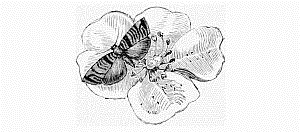
Fig. 232. – Pomonella.
The same extensive family contains a few moths that are very destructive to our fruits, the larvæ burrowing into and living entirely within their substance. One of these —Pomonella– is popularly known as the Codlin, as its larva is so often found in the interior of small apples of the same name.
The fore wings of this insect are grey, with a number of dark transverse lines. The spot in the anal angle is edged with a coppery tint, and inclosed by a curved black line.
This moth is common in all parts, flying during June and July; and the larva may be looked for in apples and pears in August and September.
Xanthosetia zoegana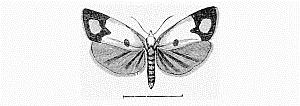
Fig. 233. – Zoegana – Enlarged.
Our last example of the Tortrices is Zoegana, which belongs to the family Conchylidæ. Its fore wings are yellow, with a reddish streak along the costa near the base, and a small reddish spot opposite this near the inner margin. The tip of the wings is dark reddish brown, in the middle of which is a large yellow spot.
This moth is widely distributed, and in some parts common. It flies from May to August, and the larva feeds on the small scabious (Scabiosa columbaria).
The TineæWe have noticed that the Tortrices form a very extensive group of moths, but they are far outnumbered by the Tineæ, for of these there are over seven hundred known British species.
Of course, among so many species we are sure to find considerable variety in form and structure; but notwithstanding this, the Tineæ form a well-marked division, and the beginner will find but little difficulty in distinguishing between these and the other Micros.
The wings are long and narrow, and are remarkable for the length of the fringe, particularly that of the hind wings. The bodies, too, are long and slender.
The larvæ are exceedingly variable. Some have the usual number of sixteen limbs, and others have as many as eighteen. Again, the larvæ of several genera have only fourteen legs, and some are absolutely legless.
With regard to their food and habits, they are equally variable, for while some feed exposed, others are always protected in rolled leaves. Some construct for themselves portable tubes, so that they always remain under cover, and are at the same time perfectly free to ramble in search for food. Some, also, are leaf miners; and the group includes the so-called 'Clothes Moths,' whose larvæ devour our garments, furs, and the upholstering of our furniture.
We shall now briefly notice a few species, in order that we may become better acquainted with the general characters of the group.
Diurnea fagellaThis moth represents the small family Epigraphiidæ, containing only six species, all of which appear in the winter or early spring.

Fig. 234. – Fagella.
The present species is very common in most parts, and may be seen at rest on the barks of trees in March and April.
The fore wings are usually pale grey or yellowish grey, and dotted with brown; but there is a great variety both in the depth of the ground colour and the distinctness of the markings. Our illustration gives the usual appearance of the insect.
The caterpillar feeds on various trees in September and October, always protected between leaves that it has spun together.
Adela cuprella
Fig. 235. – Cuprella.
The family Adelidæ contains ten species, all remarkable for the great length of their antennæ. The one selected for illustration is a beautiful little moth with bright bronzy green fore wings, tinged with a rich glossy violet. The hind wings are brown with a glossy surface.
This moth does not seem to be widely distributed, but is fairly plentiful where it occurs. Wimbledon Common and Epping Forest are good localities for it. It is on the wing in April and May.
Hyponomeuta PadellusThe family Hyponomeutidæ contains about twenty insects, some of which are very common and exceedingly destructive to our trees. In May and June hawthorn and fruit trees may be seen swarming with the gregarious larvæ of some of them, and almost entirely stripped of their leaves.

Fig. 236. – Padellus.
The species here figured has grey or white fore wings with three rows of black dots. The hind wings are darker grey without dots.
The larva feeds on hawthorn, apple, and other trees. The perfect insect flies in July and August.
Depressaria nervosa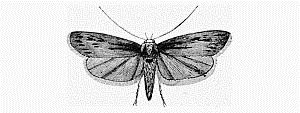
Fig. 237. – Nervosa – Twice Natural Size.
The next family —Gelechiidæ– is represented by the species Nervosa, which is common in many localities.
Its fore wings are reddish brown, and are marked by a number of short longitudinal streaks of a darker colour. The hind wings are light grey.
The caterpillar is black, marked with black spots in white rings, and having yellow side stripes. It feeds on the flowers of the hemlock water dropwort (Œnanthe crocata) during June and July.
The moth flies in August and September.
Harpella Geoffrella
Fig. 238. – Geoffrella.
The same extensive family contains the moth Geoffrella, represented in the accompanying cut. This is an exceedingly pretty insect. The basal portion of its fore wings is yellow, with two longitudinal dark streaks, the outer one of which is bent towards the inner margin near the middle of the wing. The remaining portion of the wings is brown, with two yellowish triangular spots, one on the costal and one on the inner margin. On the middle of the costa is a short dark streak.
This moth appears in May and June, and is rather local, but very abundant in some parts.
Coleophora ibipennella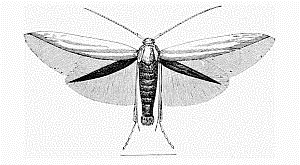
Fig. 239. – Ibipennella – Enlarged.
The family Coleophoridæ contains about seventy small moths, characterised by their very narrow and pointed wings, with long fringes, and also, generally, by a little tuft of hair on the first joint of the antennæ.
The larvæ live in little cases which they construct, and feed on various leaves and seeds. They spend the winter within their cases, and change to the chrysalis state in spring or early summer.
One of these moths —Ibipennella– is shown in fig. 239. Its fore wings are white, with a satiny gloss, and brownish towards the tips. The 'nervures' are generally of a yellowish tinge. The hind wings are dark grey.
The larva feeds on the birch (Betula alba), and may be seen walking on the surface of the leaves, carrying, or rather dragging after it, the pistol-shaped case in which it lives, nothing protruding save its head and front legs. It is full fed in May, and the moth flies in July.

